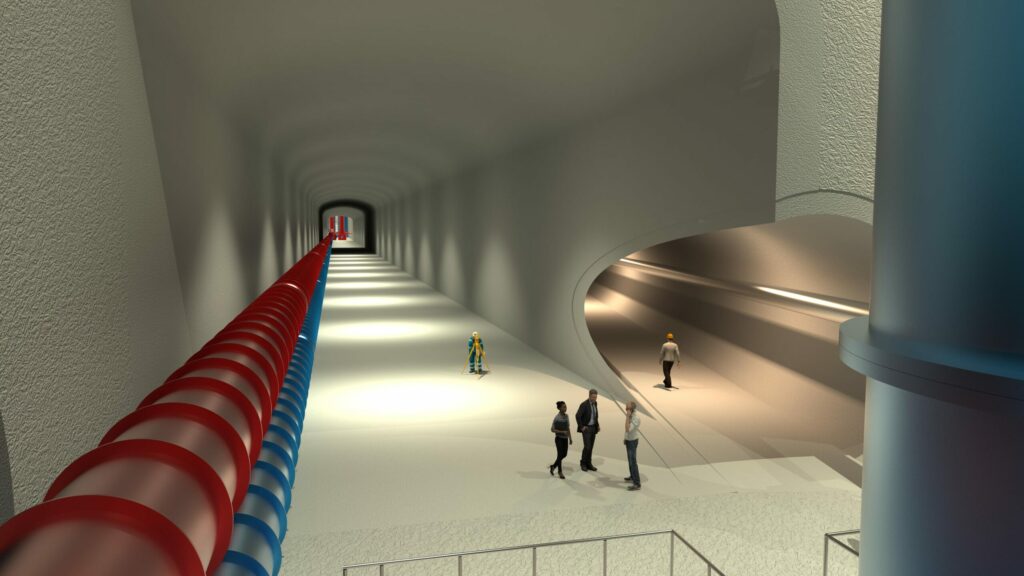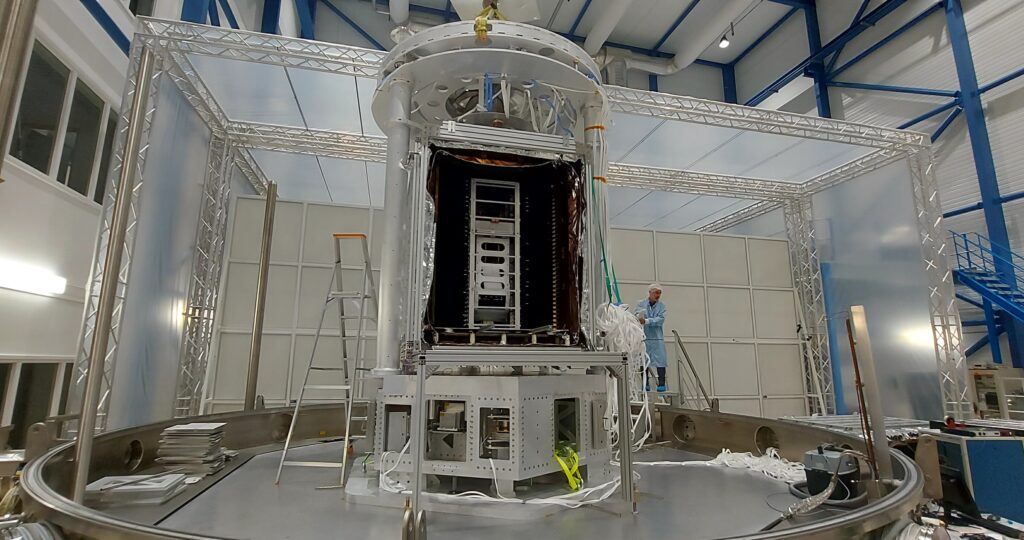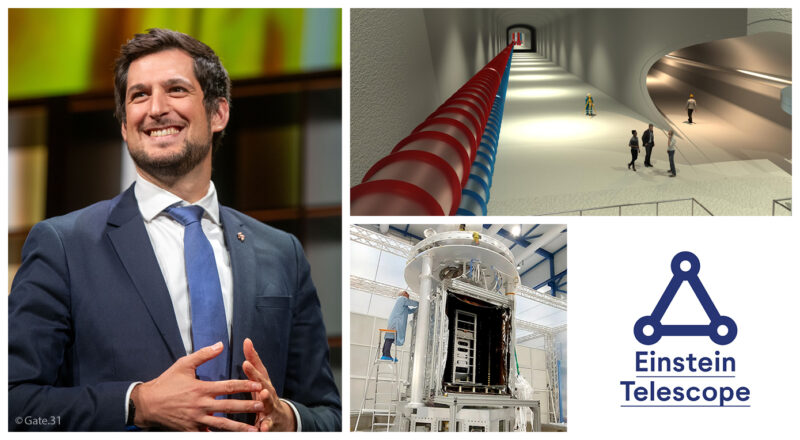Since 2019, Germany, the Netherlands and Belgium have been working together to create the Europe’s most advanced observatory for gravitational waves in the Euregio Meuse-Rhine region. Wallonia is involved in this project, as 70% of the infrastructure could be located underground in Wallonia, more specifically in Plombières, Aubel and Welkenraedt.
A new window on the Universe…
The three 10-kilometer tunnels of the Einstein Telescope will be sited 250 to 300 meters underground to make undisturbed measurements of gravitational waves. Above ground, hardly anything will be visible of the observatory.

The Einstein Telescope measures gravitational waves by constantly monitoring the length of its three detector corridors with sensitive lasers and vibration-free suspended lasers. If that length changes in a specific pattern, it is the signal of a passing gravity wave. The Einstein Telescope will detect a thousand times more gravity waves than its predecessors.
Gate.31 spoke with Adrien Dolimont, Minister-President of the Walloon Region (Belgium), about the Einstein Telescope and the future of research, innovation, and technology in Wallonia.
This project is strategic in several respects. First, like any large-scale research initiative, the Telescope is expected to drive significant technological advances and innovations that will benefit society as a whole. This is what we refer to as « research for the benefit of humanity ».
Second, it highlights Belgian – and more specifically, Walloon – expertise in research and development.
Furthermore, we must not forget that the Einstein Telescope is a large-scale initiative supported by the European Union, and fully aligned with the broader effort to build the European Research Area.
That is why we are firmly committed to the project. We have already announced €200 million in funding.

‣ Several factors give Belgium a strong position in the selection process.
First, the nature of the soil appears well-suited for dampening vibrations. The top layer is soft and absorbs shocks, while beneath it lies a hard rock layer – ideal for tunnel construction. Naturally, this will need to be confirmed by the latest drilling and seismic studies.
In addition, the Three Borders region lies at the heart of an area that is highly developed in terms of high technology, featuring leading universities in Liège, Maastricht, and Hasselt, as well as outstanding research institutes and a strong high-tech industry.
These research institutes and companies are already working closely together on preparatory activities. Over €100 million has already been invested in research and innovation projects across the three countries, underscoring the strength of this collaboration. In addition, European programmes such as E-Test, ET2SMEs, and ETT are supporting this cross-border cooperation – not only with large innovative companies, but also with small and medium-sized enterprises. Furthermore, the region offers an attractive international living environment and a favorable business climate, supported by strong infrastructure, a high-quality education system, and a multilingual population.
It is also exceptionally well connected – by road, rail, air (with several international airports), and inland waterways.
This cutting-edge industrial and scientific ecosystem is well positioned to support a project of this scale in both a credible and competitive way.
Finally, Belgium backs a particularly promising technological approach. Our proposal features the construction of a triangular-shaped telescope — a configuration with proven scientific advantages.
The unique feature of the Einstein Telescope’s triangular design is that it combines the benefits of three differently oriented interferometers within a single underground structure. This setup eliminates certain technical challenges, reduces what is known as instrumental noise, and offers significantly greater sensitivity than current observatories.

“The Einstein Telescope is an exceptionally large-scale project — relatively speaking, comparable to CERN in Geneva. From an economic perspective, the benefits would be substantial in both the short and long term, as the establishment of such an infrastructure would create a true scientific, industrial, and technological ecosystem around the site” – Adrien Dolimont
‣ Einstein Telescope: major research projects
In 2026, Wallonia will learn whether the project will become a reality on its territory. In the meantime, the Walloon Region has launched four major research projects:
- ETGEO: focused on studying the subsoil to determine the optimal location for the Telescope,
- ETOPT: aimed at developing innovative laser and optical solutions for the Telescope’s interferometers,
- CRISTAL: centered on the development of a cryogenic mirror prototype to establish a laboratory dedicated to research in cryogenic technologies,
- ETLOG: given the massive amount of data generated by the Telescope, this project focuses on developing advanced software and a robust computing infrastructure to process this data efficiently.
The four industrial research projects continue to progress, showcasing the region’s ability to mobilize its scientific and technological ecosystem around this exceptional infrastructure.
“These projects position Wallonia as a major technological player in the fields of optics, cryogenics, geology, and advanced logistics” – Adrien Dolimont.
The Einstein Telescope is a large-scale initiative that engages a sector – space sciences and fundamental physics – that holds a prominent place in the Walloon economy. The benefits of this project will be positive for both SMEs and research centers, fostering cross-border economic and scientific exchanges.
We often talk about building the region’s technological future. What exactly do you mean by that?
My colleague Pierre-Yves Jeholet and I are working on reforming the research decree, in line with major European guidelines. It’s not just about supporting research – it’s about structuring our ecosystem to ensure the critical mass needed to compete on an international scale.
“Today, we have many research centers, but we need to consolidate the sector so that these centers are large enough to become – or remain – leaders in their fields of expertise on an international scale” – Adrien Dolimont.
Ultimately, I would like Belgium – and Wallonia in particular – to be easily recognized internationally for key themes such as:
- Research into advanced materials
- Digital simulation
- Information technologies, including applications related to artificial intelligence
These are areas in which we already have solid expertise, and there is every reason to be proud! My goal today is to define and implement a strategic approach to enhance the visibility, scientific impact, and attractiveness of our research centers to talented individuals and international partners.
What key message would you like to convey in Belgium and abroad regarding Wallonia’s bid for the Einstein Telescope?
This project represents an exceptional opportunity to position Wallonia as a European leader in fundamental physics, to mobilize our industrial ecosystem around cutting-edge technologies, to forge new partnerships with neighboring regions, and ultimately, to build a renewed image of Wallonia as an innovative and ambitious region!



